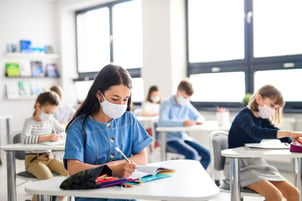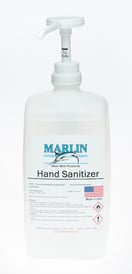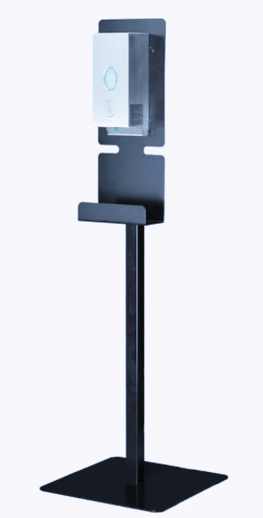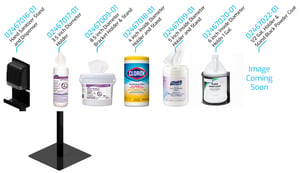
For many schools and families, back to school planning will look different than any other year. Of course, there may still be the trips to the office department store for new pads of paper and pencils. The major difference? Not all students will be returning to the classroom due to the COVID-19 pandemic. Many schools are opting for virtual learning, which comes with its own separate challenges. However, for schools that are still opening up in the fall for in-person learning, there are a host of challenges to ensure student and campus safety.
That’s why Marlin Steel has been doing its part helping to fight infectious disease control and keeping schools safe. Follow this student safety checklist to help keep your campus as safe as possible as students return to classrooms in the fall.
Student Safety Checklist for Campuses Reopening Amidst COVID-19
As schools reopen, teachers, families, and students all have a part to play to enhance campus safety and ensure students are receiving the most out of their education while keeping healthy. This student safety checklist can help facilitate infectious disease control throughout classrooms and hallways as students return in the fall.
Review Hand-Washing Techniques
Proper hand-washing procedures are a major component of infectious disease control. The CDC recommends washing hands with soap and water for at least 20 seconds or using hand sanitizer with at least 60% alcohol content to prevent any COVID-19 transmission. Students  and faculty should wash their hands or use sanitizing solutions after:
and faculty should wash their hands or use sanitizing solutions after:
- Before eating or preparing food
- Before touching your face
- After using the restroom
- After leaving a public place
- After touching public surfaces
- After blowing your nose, coughing, or sneezing
- After handling your mask
- After sharing objects with other students
Schools must ensure that students and faculty have enough hand sanitizer. Since hand washing is limited to areas with sinks, hand sanitizer may be a more accessible option for infectious disease control. Additionally, regularly sanitizing public surfaces can greatly reduce the chances of disease transmission. Coronaviruses - like COVID-19 - can live on surfaces from several hours to days; if an infected student touches a door handle, other students can become infected if they do the same within that period of time. Ensuring your school has enough hand sanitizer in storage to supply your hallways, lunchrooms, gymnasiums, and classrooms should be a high priority for student safety.
Placing Hand Sanitizer Dispensers Throughout Your Campus
Keeping your hands clean is an effective way to prevent COVID-19 and flu transmission, but  hand washing may not always be the most accessible solution. If sinks are only located in restrooms, then schools may have a hard time facilitating proper infectious disease control. For instance, young students may not understand the importance of hand washing if it means they have to walk a far distance to the restroom to wash their hands.
hand washing may not always be the most accessible solution. If sinks are only located in restrooms, then schools may have a hard time facilitating proper infectious disease control. For instance, young students may not understand the importance of hand washing if it means they have to walk a far distance to the restroom to wash their hands.
Meanwhile, hand sanitizer stations are a convenient way to ensure the most sterile conditions in your school since they can be set up in the most accessible locations for students and staff. By strategically placing sanitizer stands in hallways, lunchrooms, classrooms, and other areas of high traffic, students will be encouraged to practice good hygiene. Whereas some students may be inclined to skip frequent hand washing if it entails taking a trip to a restroom or hand sanitizer stations on the other side of the school, conveniently located hand sanitizer stands will encourage frequent usage and consistent infectious disease control.
Adhering to Social Distancing Guidelines When Possible
Limiting close contact with other people significantly helps to reduce the risk of becoming infected with COVID-19. Social distancing, or keeping at least six feet apart from other people, is an effective way to reduce distance with another person. Since COVID-19 disperses when an infected person coughs, sneezes, or talks, spreading infected droplets, limiting face-to-face contact is especially important for reducing the risk of transmission.
Social distancing measures in schools will be vitally important for limiting the spread of the virus. However, as any teacher, parent, or student knows, social distancing among the student body will be nearly impossible at times. For instance, 2nd graders may not understand that they can’t share toys or keep a distance away from each other! Though it may be difficult, it's important schools do their best to implement distance for both faculty and student safety.
Here are some tips from the CDC for social distancing during the school day:
- Space desks out to six feet apart to allow for social distancing in the classroom.
- Limit class sizes to a particular amount. Classes are broken into groups and stay with the same teacher and students throughout the day.
- Students do not share supplies, toys, or objects with one another.
- Ensure students wear cloth face coverings throughout the day.
- Turn desks to face in the same direction, as opposed to facing each other. Or, have students only sit on one side of the tables and spaced apart.
- Provide physical guides on walls or floors to help students and faculty remain six feet apart. This can look like colored tape or stickers.
Hopefully, these tips can help facilitate social distancing guidelines and student safety this fall! For more resources on infectious disease control for schools, check out more from the CDC’s website for community, work, and school recommendations.
Marlin Steel's Solutions Can Help You Keep Your Students & Faculty Safe!
Ever since the outbreak of the COVID-19 pandemic, Marlin Steel’s team of degreed engineers has been  manufacturing and designing equipment for infectious disease control and COVID-19 testing efforts. As part of their continuing support towards institutions and businesses during the COVID-19 pandemic, Marlin Steel now offers a sanitizer dispenser and stands for these purposes to enable the most effective sanitation solutions for schools and facilities.
manufacturing and designing equipment for infectious disease control and COVID-19 testing efforts. As part of their continuing support towards institutions and businesses during the COVID-19 pandemic, Marlin Steel now offers a sanitizer dispenser and stands for these purposes to enable the most effective sanitation solutions for schools and facilities.
The Marlin Steel hand sanitizer dispenser is no-touch and can hold up to 30 oz of sanitizer fluid. And features a refill indicator window so you can be alerted when the solution volume is getting low. The dispenser fits well with the Marlin Steel hand sanitizer stand, though the stand also is engineered to accommodate several different dispenser models. The stand can also be easily moved to convenient locations or areas of high traffic for increased organization and accessibility in your school.
Marlin Steel also offers hand sanitizer for your dispensers and sanitation needs so you don’t have to worry about running out of sanitizer. Marlin hand sanitizer kills harmful bacteria and germs, including the COVID-19 virus, and follows the WHO-Recommended formulation #1.
Interested in learning more about how Marlin Steel’s hand sanitizer or other PPE equipment can ensure student safety this fall? Reach out to the experts at Marlin Steel today!



.gif)


